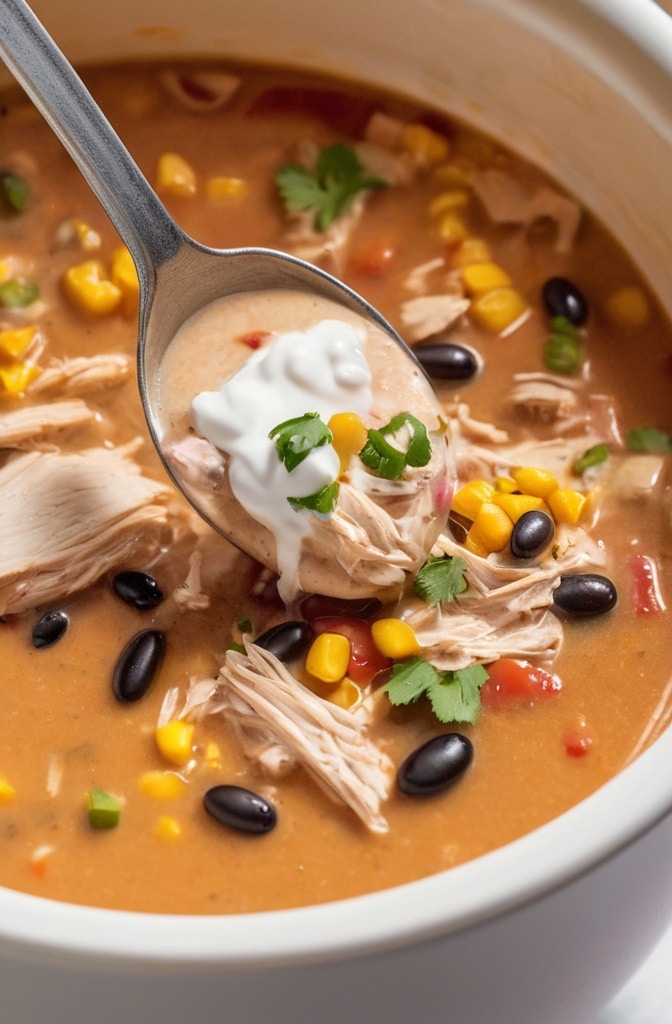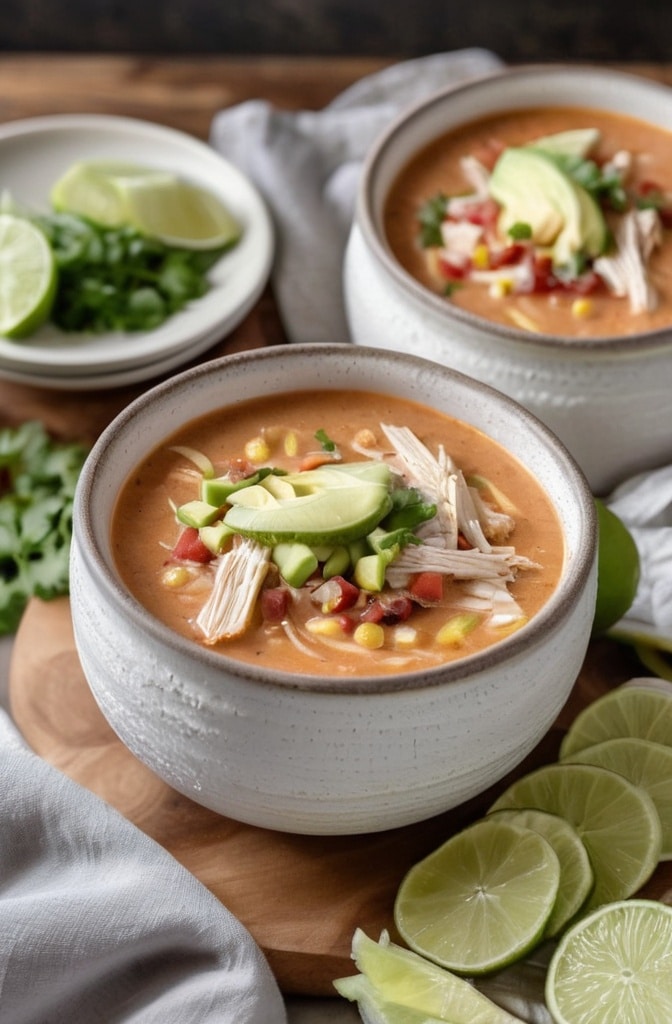The first time I made Creamy Instant Pot Chicken Taco Soup during a blizzard in Colorado, my kitchen windows fogged with aromatic steam that drew my neighbors across the street – trudging through knee-deep snow just to discover what heavenly concoction was brewing. Their persistence payed off. We ended up sharing that pot of soup among six adults, two teenagers, and a very determined golden retriever who refused to be excluded from the festivities.
This isn’t just another taco soup recipe. Creamy Instant Pot Chicken Taco Soup represents the beautiful evolution of traditional Mexican flavors through modern technique. The pressure cooker transforms what would typically be a long-simmered dish into something achievable on even the busiest weeknight, without sacrificing an ounce of depth or complexity.
The magic happens when pressure-cooked chicken breaks down into tender, succulent morsels that absorb surrounding spices, while the dairy components meld into a velvety backdrop that carries the bright, bold flavors of traditional taco seasonings.
The Appeal of Pressure Cooker Taco Soup
What makes this dish so compelling is its uncanny ability to taste like it’s been simmering all day when it’s actually been cooking for mere minutes. The Instant Pot creates an intensely pressurized environment that forces flavors to penetrate deeply into ingredients while dramatically reducing cooking time.
Traditional stovetop taco soups often require careful monitoring and regular stirring to prevent scorching. Not here. The Instant Pot’s even heat distribution eliminates hot spots and creates a gentle, uniform cooking environment that allows you to walk away completely. This “set it and forget it” approach doesn’t just save time—it actually improves flavor development.
For home cooks and professionals alike, this recipe represents the perfect intersection of convenience, technique, and flavor. It’s the kind of dish that builds your reputation as someone who understands the subtleties of flavor layering and textural contrast. Yet behind that sophistication lies an approachable process that anyone can master.
Ingredients & Substitutions
The Foundation
- 1½ pounds boneless, skinless chicken breasts (or thighs)
- 1 medium yellow onion, diced
- 4 garlic cloves, minced
- 1 red bell pepper, diced
- 1 jalapeño, seeded and finely diced (optional)
- 2 tablespoons olive oil
- 1 tablespoon tomato paste
- 1 can (15 oz) black beans, drained and rinsed
- 1 can (15 oz) corn kernels, drained (or 1½ cups frozen)
- 1 can (10 oz) diced tomatoes with green chilies
- 1 can (15 oz) fire-roasted tomatoes
- 4 cups chicken broth (preferably low-sodium)
The Flavor Profile
- 2 tablespoons taco seasoning (store-bought or homemade)
- 1 teaspoon ground cumin
- 1 teaspoon dried oregano
- ½ teaspoon smoked paprika
- ¼ teaspoon cayenne pepper (adjust to taste)
- 1 bay leaf
- Salt and freshly ground black pepper
The Creamy Element
- 8 oz cream cheese, softened and cubed
- 1 cup heavy cream or half-and-half
- 1 cup shredded cheddar or Mexican-blend cheese
Garnishes
- Fresh cilantro, chopped
- Lime wedges
- Avocado slices
- Tortilla strips or crushed tortilla chips
- Sour cream
- Additional shredded cheese
Let’s talk substitutions, because this recipe welcomes them with open arms. For a lighter version, swap the chicken breasts for ground turkey (93% lean works beautifully). Vegetarians can replace the chicken with an extra can of beans and perhaps some diced zucchini or yellow squash for texture.
The dairy components provide crucial richness, but they can be modified for dietary concerns. Neufchâtel cheese offers similar creaminess with about 1/3 less fat than standard cream cheese. Those avoiding dairy entirely might consider cashew cream or coconut milk, though the flavor profile will shift slightly toward the tropical.
Bean selection deserves special attention. While black beans offer traditional flavor and stunning visual contrast, pinto beans actually provide a creamier texture that melts more seamlessly into the soup. For adventurous cooks, hominy delivers an authentic Mexican touch with its distinctive chew and corn-forward flavor.
Fresh versus dried herbs presents another decision point. While dried oregano works perfectly fine in pressure cooking (and might even be preferable since it withstands high pressure better), finish the soup with fresh cilantro just before serving. The volatile compounds in fresh herbs provide bright, vivid flavors that would be destroyed during pressure cooking.
Step-by-Step Instructions

Preparation Phase
- Begin by cutting your chicken into large chunks (approximately 2-inches). This size maximizes surface area for flavor absorption while preventing the meat from disintegrating completely during cooking. Season generously with salt and pepper.
- Set your Instant Pot to “Sauté” mode and add olive oil. Once shimmering hot (but not smoking), add chicken pieces in a single layer. Work in batches if necessary – overcrowding is the enemy of proper browning. Don’t disturb the chicken for at least 2 minutes to develop a golden crust.
Rookie mistake: Constantly moving or flipping the chicken pieces. Patience rewards you with flavor-packed fond (those golden-brown bits) that forms the foundation of your soup’s complexity.
- Remove browned chicken (it won’t be fully cooked) and set aside. In the same pot, add diced onion and cook until translucent, about 3 minutes. Add bell pepper and jalapeño, continuing to sauté for another 2 minutes until slightly softened.
- Add garlic and cook just until fragrant, about 30 seconds. Immediately add tomato paste and stir continuously for 1 minute. This brief “toasting” of tomato paste develops rich umami notes that would otherwise remain dormant.
The aromatics shouldn’t be allowed to brown excessively – you’re aiming for softened vegetables that will eventually melt into the soup’s background. Think of them as the bass notes in your flavor symphony.
Building The Soup
- Return the chicken to the pot. Add black beans, corn, both cans of tomatoes (with their juices), taco seasoning, cumin, oregano, smoked paprika, cayenne, and bay leaf. Pour in chicken broth and stir to combine, scraping up any browned bits from the bottom of the pot.
Pro tip: This deglazing step isn’t just about flavor – it prevents the dreaded “BURN” notice on your Instant Pot by ensuring nothing is stuck to the bottom.
- Secure the Instant Pot lid, ensuring the valve is set to “Sealing” position. Select “Pressure Cook” (or “Manual” on older models) and set for 12 minutes at high pressure. Keep in mind that the pot will take approximately 10-15 minutes to come to pressure before the actual cooking time begins.
- When cooking cycle completes, allow natural pressure release for 10 minutes, then carefully perform a quick release for any remaining pressure. Remove the bay leaf and discard.
The natural release is critical here – it allows the chicken fibers to relax and reabsorb juices, resulting in more tender meat. Rushing this step leads to tough chicken that’s contracted and expelled its moisture.
The Creamy Transformation
- Remove approximately 2 cups of chicken pieces and shred them using two forks. Return the shredded chicken to the pot. This technique creates textural variation – some pieces remain chunky while others integrate completely into the broth.
- Switch to “Sauté” mode on low. Add cubed cream cheese, stirring gently until completely melted. The small cubes expose more surface area, helping the cheese incorporate smoothly without requiring aggressive stirring that would break down your soup components.
- Stir in heavy cream and shredded cheese until fully incorporated and heated through. Taste and adjust seasonings as needed – the dairy components mellow heat and salt, so you might need more than you expect.
Finishing variation: For an extra dimension, stir in the zest and juice of one lime just before serving. The brightness cuts through the richness and amplifies the Mexican flavor profile exponentially.
Cooking Techniques & Science
The Instant Pot revolutionizes this dish through several critical food science principles. First, pressure cooking raises the boiling point of water from 212°F to approximately 250°F. This temperature shift accelerates the Maillard reaction the complex chemical process responsible for creating hundreds of new flavor compounds when proteins and sugars interact under heat.
What might take hours on a stovetop happens in minutes under pressure. This is particularly noticeable with tough cuts of meat, where collagen transforms into gelatin rapidly, creating that coveted melt-in-your-mouth texture. The pressure environment also forces liquid into the meat fibers, essentially infusing them with flavor from the inside out.
Equally important is how the sealed environment prevents volatile flavor compounds from evaporating. Think about the difference between sniffing an open pot of soup versus opening a pressure cooker after cooking. That intense aroma burst when releasing pressure? Those are concentrated flavor molecules that would have otherwise disappeared into your kitchen air.
The layering technique employed here building flavors sequentially rather than dumping everything in at once – creates what professional chefs call “flavor scaffolding.” Each ingredient contributes distinct notes that support and enhance the others. The initial sautéing of aromatics establishes a foundation upon which other flavors can build.
Dairy incorporation presents specific scientific challenges. High heat or rapid temperature changes can cause proteins in cream and cheese to separate, creating a grainy texture. By adding these elements after pressure cooking, when temperatures have moderated, and incorporating them gradually, we maintain their smooth, emulsified state.
The tomato-dairy combination deserves special attention. Tomato’s acidity can curdle dairy if introduced carelessly. Our method of pressure cooking the tomato components first allows their acids to mellow slightly before meeting the cream and cheese. Additionally, the cream cheese contains stabilizers that help prevent separation, serving as a buffer between the acidic and dairy components.
Serving & Pairing Suggestions

Presentation elevates this soup from casual to impressive. Serve in wide, shallow bowls that showcase the vibrant colors and textures. For family-style service, place the soup in a rustic earthenware tureen alongside bowls of various garnishes, allowing each person to customize their experience.
The garnish game is where this dish truly shines. Create a “taco bar” approach with individual ramekins containing:
- Crispy tortilla strips (homemade if possible – just cut corn tortillas into thin strips and fry until golden)
- Diced avocado tossed with lime juice to prevent browning
- Thinly sliced radishes for peppery crunch
- Pickled red onions for acidic contrast
- Fresh jalapeño slices for heat-seekers
- Crumbled cotija cheese for authentic Mexican flair
Temperature contrast creates memorable dining experiences. Serve the hot soup alongside cool garnishes and even chilled lime crema (simply mix sour cream with lime zest and a touch of juice). The interplay between hot and cold temperatures stimulates multiple sensory receptors simultaneously.
For comprehensive meal planning, consider these accompaniments:
- Simple side salad with jicama, orange segments, and cilantro-lime vinaigrette
- Warm corn tortillas wrapped in a kitchen towel to maintain heat
- Mexican-style rice with poblano peppers and corn
- Chilled cerveza with lime wedges or a tart sangria
Wine pairing requires careful consideration due to the soup’s creaminess and spice. A slightly off-dry Riesling handles heat beautifully while cutting through richness. For red wine enthusiasts, a fruit-forward Zinfandel with moderate tannins complements the smoky elements without fighting the creaminess.
Transformations & Variations
The recipe as presented represents just one point on a spectrum of possibilities. Consider these creative directions:
Seafood Adaptation
Replace chicken with firm white fish and shrimp added during the last few minutes of cooking. The seafood variation pairs beautifully with a touch of coconut milk and extra lime.
Vegetarian Transformation
Double the beans, add diced mushrooms (portobello or cremini work well), and replace chicken broth with vegetable stock. The umami from mushrooms provides depth that meat-eaters won’t miss.
Breakfast Remix
Thin the leftover soup slightly with additional broth and poach eggs directly in the hot soup. Serve with toasted bolillo bread for a Mexican-inspired breakfast that revitalizes day-old soup.
Make-Ahead Strategy
The soup base (everything except dairy components) freezes beautifully for up to 3 months. When ready to serve, thaw overnight, reheat, and add fresh dairy elements. This approach gives you 90% of the flavor with significantly less last-minute effort.
Conclusion
Creamy Instant Pot Chicken Taco Soup represents what I love most about modern cooking – the thoughtful application of technology to honor traditional flavors while adapting to contemporary lifestyles. This dish doesn’t just feed people; it creates moments of connection around the table.
What makes this recipe truly exceptional is its accessibility to cooks of all skill levels. Beginners can follow the steps for reliable, impressive results, while seasoned professionals will appreciate the opportunities for creative variation and technique refinement.
The marriage of pressure cooking with carefully sequenced ingredient additions produces something greater than the sum of its parts. It’s a dish that feels simultaneously innovative and familiar – pushing boundaries while remaining firmly rooted in comfort food territory.
Remember that recipes are living documents, not rigid prescriptions. Your kitchen, your ingredients, and your palate will guide adjustments that make this soup uniquely yours. Perhaps your version will become the one that draws neighbors through a snowstorm, creating memories that last far longer than the leftovers (though those are pretty magnificent too).
FAQs
Can I make this recipe with frozen chicken?
Absolutely! Add 5 minutes to the pressure cooking time (17 minutes total). Skip the initial browning step and add 1 teaspoon of smoked paprika to compensate for the missing Maillard reaction flavors. The texture will be slightly different but still delicious.
Why did my cream cheese not fully incorporate?
Temperature differential is usually the culprit. Next time, ensure your cream cheese sits at room temperature for at least 30 minutes before adding. Alternatively, whisk the cream cheese with a cup of hot broth in a separate bowl until smooth, then add this mixture back to the pot.
How can I make this soup less spicy for children or sensitive palates?
Omit the jalapeño and cayenne entirely, use mild diced tomatoes with green chilies, and offer hot sauce on the side for adults. The dairy components naturally temper heat, making this soup adaptable for family meals with varying spice preferences.
My soup seems too thin. How can I thicken it?
The simplest solution is to continue simmering on “Sauté” mode (low setting) with the lid off to reduce liquid. For immediate results, make a slurry with 1 tablespoon cornstarch and 2 tablespoons cold water, then stir into the simmering soup until thickened.
Can this recipe be doubled for large gatherings?
Yes, with caution. Most 6-quart Instant Pots shouldn’t exceed 2/3 capacity for pressure cooking. Double ingredients but maintain the same pressure cooking time. For very large groups, consider making two batches or using an 8-quart model. The flavors actually improve after a day, so making it ahead is advantageous.

